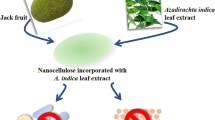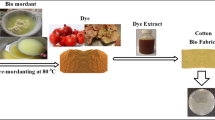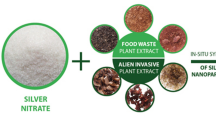Abstract
With the aim to develop biodegradable quality sanitary pads at affordable prices to the schoolgirls and women, locally available cotton waste materials and anti-bacterial nanocolorants are used to prepare anti-bacterial biodegradable absorbent material suitable for sanitary napkins and diapers. Cotton fluff from loom waste was collected, cleaned and hydro-entangled to form absorbent sheet. The sheet shows water absorbency of more than 470%. Electrochemically synthesized natural extract (from neem and orange peel) based nanocolorants were incorporated in the material to improve their anti-bacterial ability. Further, microporous polylactic acid biodegradable sheet was used to pack the absorbent layer and its performance was tested. This anti-bacterial biodegradable absorbent pad would be an ideal substitute for synthetic sanitary pads considering its 100% biodegradability. This can provide a long-term viable alternative to the current practices.








Similar content being viewed by others
References
Manjunath NS, Rangaswamy BE Development of biodegradableeco-friendly and cost effective sanitary napkin. Bapuji institute of engineering and technology, Davangere. Project reference no. 41S-BE-2798. http://www.kscst.iisc.ernet.in/spp/41_series/SPP41S/01_Seminar_Projects/004_41S_BE_2798.pdf
Barman A, Katkar PM, Asagekar SD (2018) Natural and sustainable raw materials for sanitary napkin. Man Made Textiles India 46(12):408–411
Arugula P, Paramasivam SK, Kanuri N, Srirangam A, Vemuluri M (2017) Perception on use of sanitary napkins among students in Khammam locality: a survey. Indian J Pharm Pract 10(2):133
Rajput A, Ramachandran M, Gotmare VD, Raichurkar PP (2017) Recent bioactive materials for development of eco-friendly dippers: an overview. J Pharm Sci Res 9(10):1844–1848
Barman A, Katkar PM, Asagekar SD, Barman A, Katkar PM, Asagekar SD (2017) Development of eco-friendly herbal finished sanitary napkin. Int J 4:183–189
Pillai MM, Karpagam KR, Begam R, Selvakumar R, Bhattacharyya A (2018) Green synthesis of lignin based fluorescent nanocolorants for live cell imaging. Mater Lett 212:78–81
Obidi OF, Adelowotan AO, Johnson OO, Hassan MO, Nwachukwu SCU (2013) Antimicrobial activity of orange oil on selected pathogens. Int J Biotechnol 2(6):113–122
Eastman JA, Choi SUS, Li S, Yu W, Thompson LJ (2001) Anomalously increased effective thermal conductivities of ethylene glycol-based nanofluids containing copper nanoparticles. Appl Phys Lett 78(6):718–720
Esteban-Cubillo A, Pecharromán C, Aguilar E, Santarén J, Moya JS (2006) Antibacterial activity of copper monodispersed nanoparticles into sepiolite. J Mater Sci 41(16):5208–5212
Gopinathan J, Mano S, Elakkiya V, Pillai MM, Sahanand KS, Rai BD, Selvakumar R, Bhattacharyya A (2015) Biomolecule incorporated poly-ε-caprolactone nanofibrous scaffolds for enhanced human meniscal cell attachment and proliferation. RSC Adv 5(90):73552–73561
Portella EH, Romanzini D, Angrizani CC, Amico SC, Zattera AJ (2016) Influence of stacking sequence on the mechanical and dynamic mechanical properties of cotton/glass fiber reinforced polyester composites. Mater Res 19(3):542–547
Valodkar M, Jadeja RN, Thounaojam MC, Devkar RV, Thakore S (2011) Biocompatible synthesis of peptide capped copper nanoparticles and their biological effect on tumor cells. Mater Chem Phys 128(1–2):83–89
Bae J, Kwon H, Kim J (2018) Safety evaluation of absorbent hygiene pads: a review on assessment framework and test methods. Sustainability 10(11):4146
Acknowledgements
Authors express their gratitude to PSG Institutions for the financial and other supports to carry out this work.
Author information
Authors and Affiliations
Corresponding author
Additional information
Publisher's Note
Springer Nature remains neutral with regard to jurisdictional claims in published maps and institutional affiliations.
Rights and permissions
About this article
Cite this article
Sathishkumar, G., Aarthi, M., Senthilkumar, R. et al. Biodegradable Cellulosic Sanitary Napkins from Waste Cotton and Natural Extract Based Anti-bacterial Nanocolorants. J Indian Inst Sci 99, 519–528 (2019). https://doi.org/10.1007/s41745-019-00123-x
Received:
Accepted:
Published:
Issue Date:
DOI: https://doi.org/10.1007/s41745-019-00123-x




